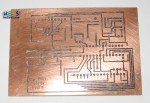Let's now explain what happens theoretically and how we can maintain and revitalize our etchant solution.
When we start to etch with our new etching solution the reaction (1) happens.
Initially our solution is transparent like the water.
The copper (Cu) reacts with hydrochloric acid (HCl) and hydrogen peroxide (H202) and produces copper cloride (CuCl2)
This is our starting etchant solution. CuCl2 gives an emerald green color to our solution.
(1)
After you are used a lot your etchant solution (dissolved a lot of copper Cu) you will finish all hydrogen peroxide (H202).
But the generated CuCl2 etches again our Cu ! Look at the reaction (2) below :
(2)
Notice that the CuCl does not dissolve the copper.
So if you continue etching all the CuCl2 will become CuCl and the solution will become brown from green that was before.
At this point your brown solution will stop etching.
But you can reactivate it by adding HCl and/or Oxygen. Look at the reaction (3)
So the CuCl re-oxides again and become CuCl2 which as we said before etches again !!!
(3)
As you can see this solution can be activated again and again. How?
1) By Controlling CuCl2
Once your solution from emerald becomes brownish you'll have to add oxygen (leaving the solution to the air) or by adding H2o2 to regenerate the solution again.
2) By Controlling HCl
As you can see from the reaction (3) HCl won't last forever.
If you notice that it's harder to re-green your brown etchant, it's probably time to add some HCl.
Let's find out now how much quantity in grams we must add HCl and H2o2
As we can see from the three reactions 4 moles of HCl react with 1 mole of H2o2
The H has an atomic mass of 1
The Cl has an atomic mass of 35,45
The O has an atomic mass of 16
This means that HCl has a molecular weight 1+35,45 = 36,45 gr/mol
and that H2O2 has a molecular weight 2*1+2*16=34 gr/mol
So 4 mole HCl (4*36,45 gr) need 1 mole H2O2 (1*34gr)
or 146 gr HCl need 34 gr H2O2
Please notice that these quantities are valid for 100% w/w solutions
We have a 15% w/w HCl solution. This means that 15 gr of HCl is present for every 100 grams of solution.
Our H202 is concentrated 3% w/w so 3gr of H2o2 are present for every 100 gr of solution.
So 146 gr HCl at 15%w/w needs 34 gr H2O2 at the same concentration 15% w/w this means 34gr*5 at a concentration 3%w/w
146 gr HCl at 15%w/w need 170 gr H2o2 at 3% w/w
But we need to find y gr HCl 15% w/w at our 200gr H2o2 at 3% w/w that we have
So 146/y HCl in gr = 170/200 => y HCl in gr = 171gr
As result we need to add 171 gr HCl 15%w/w into 200 gr H2o2 3%w/w
Below are some demonstrative photos in order to see how well works our new etchant solution.




![]()
The photos are time evolved.
As we said before the toner transfer method will be discussed in another article.
From the pictures you can see that the transparent solution becomes emerald green then dark green and at last brown.
When becomes brown your solution can not etch anymore so it is time to add hydrogen peroxide.
If you notice that it's harder to re-green your brown etchant even by adding the peroxide then add some hydrochloric acid.
Try to produce little etchant like our example since you have always to add peroxide and/or acid as the time passes.